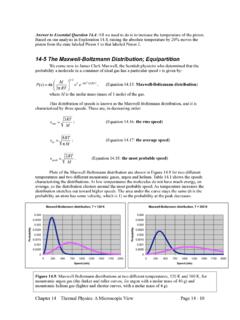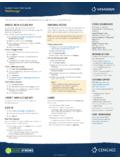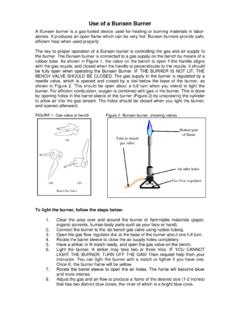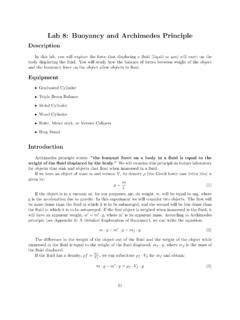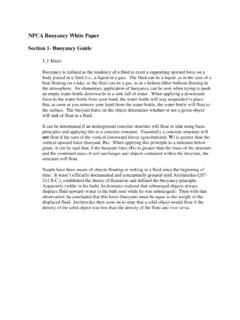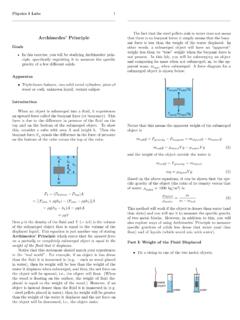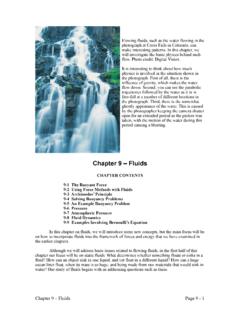Transcription of 9-5 An Example Buoyancy Problem - WebAssign
1 Answer to Essential Question : Objects that are denser than the fluid they are in tend to sink to the bottom of the container. One object in Figure already rests at the bottom, so it is in equilibrium. For the three higher objects, the force of gravity, acting down, is larger than the buoyant force that acts up. These three objects are not at equilibrium, and will sink to the An Example Buoyancy ProblemEXAMPLE Applying the general methodLet s now consider an object that sinks to the bottom of a beaker of liquid. The object is a block with a weight of 20 N, when weighed in air. The beaker it is to be placed in contains some water, as well as a waterproof scale that rests on the bottom of the beaker. This scale is tared to read zero, and let s assume the scale is unaffected by any changes in the level of the water above it.
2 The beaker itself rests on a second scale that reads 50 N, the combined weight of the beaker, the water, and the scale inside the beaker. When the 20-N block is placed in the beaker, it sinks to the bottom and comes to rest on the scale in the beaker, which now reads N. This is known as the apparent weight of the block. Let s assume g = 10 m/s2 to simplify the calculations.(a)What is the magnitude and direction of the buoyant force applied on the block by the water?(b)With the block now completely immersed in the water, what is the reading on the scale under the beaker?(c)What is the block s density and volume?SOLUTIONLet s begin with the first two steps in the general method, by drawing a diagram of the situation and a free-body diagram of the block. These are shown in Figure , where up is taken to be the positive direction.
3 Note that three forces act on the block, one of which is the downward force of gravity. The N reading on the scale is the magnitude of the downward normal force applied by the block on the scale. By Newton s Third Law, the scale applies an upward N normal force on the block. The third force acting on the block is the upward buoyant force applied on it by the water. (a) The block is in equilibrium (at rest with no acceleration), so we can apply Newton s Second Law to determine the buoyant force acting on the at the free-body diagram to evaluate the left-hand side gives:.Solving for the buoyant force gives:, directed up.(b) What is the reading on the scale under the beaker? The scale under the beaker supports everything on top of it, so with the block inside the beaker the scale under the beaker reads 70 N.
4 This comes from adding the full 20-N weight of the block to the original 50 N, from the beaker, water, and scale inside the 9 Fluids Page 9 - 10 Figure : A diagram and free-body diagram for the block resting on the scale inside the beaker of t the water support 15 N of the block s weight, via the buoyant force? Yes, it does. However, if the water exerts a force of 15 N up on the block, then by Newton s third law the block exerts a 15 N force down on the water. The water passes this force along to the beaker, which passes it along to the scale under the beaker. Similarly, the block exerts a normal force down on the scale inside the beaker, and the scale passes this force along to the beaker, which passes it along to the scale under the beaker. Now matter how you look at it, adding a 20-N block to the beaker ends up increasing the reading on the scale under the beaker by 20 N.
5 (c) Let s derive a general equation that tells us how the density of a submerged object is related to its weight mg and apparent weight Wapp. The apparent weight is numerically equal to the normal force experienced by the submerged part (a), we used Newton s Second Law to arrive at an expression for the buoyant force acting on our submerged object, obtaining:.Writing this in terms of the apparent weight gives:.For a submerged object, the apparent weight is less than the actual weight. If we call f the ratio of the apparent weight to the actual weight, , we can write the previous equation, using , as:.Now, use archimedes principle to transform the left-hand side of the equation:.Finally, write the object s mass in terms of its density:.The volume of fluid displaced by an object that is completely submerged is equal to its own volume, so we can cancel the factors of volume as well as the factors of g, leaving.
6 Solving for the density of the object, we can write the equation in various ways:.That applies generally to a completely submerged object. In our case, where we have , we find that the density of the block is: .Related End-of-Chapter Exercises: 9, Question : It is possible for small metal objects, such as sewing needles or Japanese yen, to float on the surface of water, if carefully placed there. Can we explain this in terms of the buoyant force?Chapter 9 Fluids Page 9 - 11


